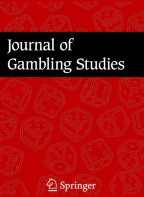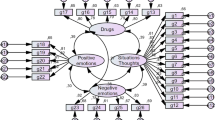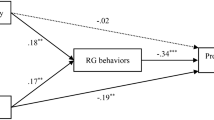Validation of the Gambling Refusal Self-Efficacy Questionnaire for Chinese Undergraduate Students

Although research on self-efficacy in the gambling literature took place more than 25 years ago, only in the recent decade did researchers attempt to develop valid and reliable measures of gambling-related self-efficacy. Recently Casey et al. (J Gambl Stud 24:229–246, 2008) developed the Gambling Refusal Self-Efficacy Questionnaire (GRSEQ) in an Australian sample, which is a valuable tool for gambling research. The first objective of this study is to validate the measure in a new sample. Given that previous research on Chinese’s gamblers’ self-efficacy is lacking, and that related research often used ad-hoc measures of the construct, a second objective of this study is to evaluate whether the GRSEQ is suitable for Chinese people. A sample of 427 university students (56.4 % females, 50.7 % gamblers) answered a questionnaire with measures including the GRSEQ, subjective norms, intentions toward gambling, general self-efficacy, impulsiveness, and pathological gambling symptoms. Evidence was found for the four-factor structure, internal consistency, criterion-related validity, and discriminant validity of the Chinese version of the GRSEQ among this young Chinese group.
This is a preview of subscription content, log in via an institution to check access.
Access this article
Subscribe and save
Springer+ Basic
€32.70 /Month
- Get 10 units per month
- Download Article/Chapter or eBook
- 1 Unit = 1 Article or 1 Chapter
- Cancel anytime
Buy Now
Price includes VAT (France)
Instant access to the full article PDF.
Rent this article via DeepDyve
Similar content being viewed by others

Psychometric Properties of the Italian Versions of the Gambling Urge Scale (GUS) and the Gambling Refusal Self-Efficacy Questionnaire (GRSEQ)
Article Open access 10 December 2019

Psychological Correlates of Disordered Gambling Tendencies Among Chinese High School and Undergraduate Students
Article 22 January 2016

The Role of Self-Esteem and Self-Efficacy in Responsible Gambling
Article 04 June 2024
Notes
Scree plot and parallel analysis were used to determine the number of factors as suggested by Fabrigar and Wegener (2012).
References
- Ajzen, I. (1991). The theory of planned behavior. Organizational Behavior and Human Decision Processes,50, 179–211. ArticleGoogle Scholar
- American Psychiatric Association. (1994). Diagnostic and statistical manual of mental disorders. Washington, DC: Author. Google Scholar
- Ashrafioun, L., McCarthy, A., & Rosenberg, H. (2012). Assessing the impact of cue exposure on craving to gamble in university students. Journal of Gambling Studies,28, 363–375. doi:10.1007/s10899-011-9262-0. ArticlePubMedGoogle Scholar
- Bandura, A. (1977). Self-efficacy: Toward a unifying theory of behavioral change. Psychological Review,84, 191–215. doi:10.1037/0033-295X.84.2.191. ArticleCASPubMedGoogle Scholar
- Bandura, A. (1990). Perceived self-efficacy in the exercise of control over AIDS infection. Evaluation and Program Planning,13, 9–17. doi:10.1016/0149-7189(90)90004-G. ArticleGoogle Scholar
- Blinn-Pike, L., Worthy, L. S., & Jonkman, J. (2007). Disordered gambling among college students: A meta-analytic synthesis. Journal of Gambling Studies,23, 175–183. ArticlePubMedGoogle Scholar
- Brislin, R. (1970). Back translation for cross-cultural research. Journal of Cross-Cultural Psychology,1, 186–216. ArticleGoogle Scholar
- Cao, F., Su, L., Liu, T., & Gao, X. (2007). The relationship between impulsivity and Internet addiction in a sample of Chinese adolescents. European Psychiatry,22, 466–471. doi:10.1016/j.eurpsy.2007.05.004. ArticlePubMedGoogle Scholar
- Caritas Addicted Gamblers Counseling Centre. (2013). Statistical report on the profile of service users (Gamblers)—15 October 2003 to 31 August 2013. Retrieved from http://www.gamblercaritas.org.hk/statistics_e.pdf.
- Casey, L. M., Oei, T. P. S., Melville, K. M., Bourke, E., & Newcombe, P. A. (2008). Measuring self-efficacy in gambling: The gambling refusal self-efficacy questionnaire. Journal of Gambling Studies,24, 229–246. doi:10.1007/s10899-007-9076-2. ArticlePubMedGoogle Scholar
- Condiotte, M. M., & Lichtenstein, E. (1981). Self-efficacy and relapse in smoking cessation programs. Journal of Consulting and Clinical Psychology,49, 648–658. doi:10.1037/0022-006X.49.5.648. ArticleCASPubMedGoogle Scholar
- Dickson, L. M., Derevensky, J. L., & Gupta, R. (2002). The prevention of gambling problems in youth: A conceptual framework. Journal of Gambling Studies,18, 97–159. ArticlePubMedGoogle Scholar
- Enders, C. K. (2001). The performance of the full information maximum likelihood estimator in multiple regression models with missing data. Educational and Psychological Measurement,61, 713–740. doi:10.1177/0013164401615001. ArticleGoogle Scholar
- Enders, C. K. (2010). Applied missing data analysis. New York, NY: Guilford. Google Scholar
- Eysenck, S. B. G., & Eysenck, H. J. (1977). The place of impulsiveness in a dimensional system of personality description. British Journal of Social and Clinical Psychology,16, 57–68. doi:10.1111/j.2044-8260.1977.tb01003.x. ArticleCASPubMedGoogle Scholar
- Fabrigar, L. R., & Wegener, D. T. (2012). Exploratory factor analysis. New York, NY: Oxford University Press. Google Scholar
- Forcehimes, A. A., & Tonigan, J. S. (2008). Self-efficacy as a factor in abstinence from alcohol/other drug abuse: A meta-analysis. Alcoholism Treatment Quarterly,26, 480–489. doi:10.1080/07347320802347145. ArticleGoogle Scholar
- Gwaltney, C. J., Metrik, J., Kahler, C. W., & Shiffman, S. (2009). Self-efficacy and smoking cessation: A meta-analysis. Psychology of Addictive Behaviors,23, 56–66. doi:10.1037/a0013529. ArticlePubMedGoogle Scholar
- Hodgins, D. C., Peden, N., & Makarchuk, K. (2004). Self-efficacy in pathological gambling treatment outcome: Development of a gambling abstinence self-efficacy scale (GASS). International Gambling Studies,4, 99–108. doi:10.1080/14459790412331296947. ArticleGoogle Scholar
- Kadden, R. M., & Litt, M. D. (2011). The role of self-efficacy in the treatment of substance use disorders. Addictive Behaviors,36, 1120–1126. doi:10.1016/j.addbeh.2011.07.032. ArticlePubMed CentralPubMedGoogle Scholar
- King, S. M., Abrams, K., & Wilkinson, T. (2010). Personality, gender, and family history in the prediction of college gambling. Journal of Gambling Studies,26, 347–359. doi:10.1007/s10899-009-9163-7. ArticlePubMedGoogle Scholar
- Ladouceur, R., Sylvain, C., Boutin, C., Lachance, S., Doucet, C., Leblond, J., et al. (2001). Cognitive treatment of pathological gambling. Journal of Nervous and Mental Disease,11, 774–780. ArticleGoogle Scholar
- Lesieur, H. R., & Blume, S. B. (1987). The South Oaks Gambling Screen (SOGS): A new instrument for the identification of pathological gamblers. American Journal of Psychiatry,144, 1184–1188. ArticleCASPubMedGoogle Scholar
- Lin, M.-P., Ko, H.-C., & Wu, J. Y.-W. (2008). The role of positive/negative outcome expectancy and refusal self-efficacy of Internet use on Internet addiction among college students in Taiwan. Cyberpsychology & Behavior,11, 451–457. doi:10.1089/cpb. 2007.0121. ArticleGoogle Scholar
- Loo, J. M. Y., Raylu, N., & Oei, T. P. S. (2008). Gambling among the Chinese: A comprehensive review. Clinical Psychology Review,28, 1152–1166. doi:10.1016/j.cpr.2008.04.001. ArticlePubMedGoogle Scholar
- Martin, R. J., Usdan, S., Nelson, S., Umstattd, M. R., LaPlante, D., Perko, M., et al. (2010). Using the theory of planned behavior to predict gambling behavior. Psychology of Addictive Behaviors,24, 89–97. doi:10.1037/a0018452. ArticleCASPubMedGoogle Scholar
- May, R. K., Whelan, J. P., Steenbergh, T. A., & Meyers, A. W. (2003). The Gambling Self-Efficacy Questionnaire: An initial psychometric evaluation. Journal of Gambling Studies,19, 339–357. doi:10.1023/A:1026379125116. ArticlePubMedGoogle Scholar
- Muthén, L. K., & Muthén, B. O. (2011). Mplus user’s guide (6th ed.). Los Angeles, CA: Muthén & Muthén. Google Scholar
- Pek, J., & MacCallum, R. C. (2011). Sensitivity analysis in structural equation models: Cases and their influence. Multivariate Behavioral Research,46, 202–228. doi:10.1080/00273171.2011.561068. ArticleGoogle Scholar
- Raylu, N., & Oei, T. P. (2004). Role of culture in gambling and problem gambling. Clinical Psychology Review,23, 1087–1114. doi:10.1016/j.cpr.2003.09.005. ArticlePubMedGoogle Scholar
- Shaffer, H. J., & Hall, M. N. (2001). Updating and refining prevalence estimates of disordered gambling behaviour in the United States and Canada. Canadian Journal of Public Health,92, 168–172. CASPubMedGoogle Scholar
- Sylvain, C., Ladouceur, R., & Boisvert, J.-M. (1997). Cognitive and behavioral treatment of pathological gambling: A controlled study. Journal of Consulting and Clinical Psychology,65, 727–732. doi:10.1037/0022-006X.65.5.727. ArticleCASPubMedGoogle Scholar
- Symes, B. A., & Nicki, R. M. (1997). A preliminary consideration of cue-exposure, response-prevention treatment for pathological gambling behaviour: Two case studies. Journal of Gambling Studies,13, 145–157. doi:10.1023/A:1024951301959. ArticleCASPubMedGoogle Scholar
- Tang, C. S., Chua, Z., & Wu, A. M. S. (2011). Impulsivity, life stress, refusal efficacy, and problem gambling among Chinese: Testing the diathesis–stress–coping model. International Journal of Stress Management,18, 263–283. doi:10.1037/a0023812. ArticleGoogle Scholar
- Tang, C. S., & Oei, T. P. (2011). Gambling cognition and subjective well-being as mediators between perceived stress and problem gambling: A cross-cultural study on White and Chinese problem. Psychology of Addictive Behaviors,25, 511–520. doi:10.1037/a0024013. ArticlePubMedGoogle Scholar
- Tang, C. S., & Wu, A. M. S. (2012). Impulsivity as a moderator and mediator between life stress and pathological gambling among Chinese treatment-seeking gamblers. International Journal of Mental Health and Addiction,10, 573–584. doi:10.1007/s11469-011-9355-0. ArticleGoogle Scholar
- Tao, V. Y. K., Wu, A. M. S., Cheung, S. F., & Tong, K. (2011). Development of an indigenous inventory GMAB (gambling motives, attitudes and behaviors) for Chinese gamblers: An exploratory study. Journal of Gambling Studies,27, 99–113. doi:10.1007/s10899-010-9191-3. ArticlePubMedGoogle Scholar
- Toneatto, T., & Ladoceur, R. (2003). Treatment of pathological gambling: A critical review of the literature. Psychology of Addictive Behaviors,17, 284–292. doi:10.1037/0893-164X.17.4.284. ArticlePubMedGoogle Scholar
- Wong, I. L. K., & So, E. M. T. (2003). Prevalence estimates of problem and pathological gambling in Hong Kong. American Journal of Psychiatry,160, 1353–1354. doi:10.1176/appi.ajp.160.7.1353. ArticlePubMedGoogle Scholar
- Worthington, R. L., & Whittaker, T. A. (2006). Scale development research a content analysis and recommendations for best practices. The Counseling Psychologist,34, 806–838. doi:10.1177/0011000006288127. ArticleGoogle Scholar
- Wu, A. M. S., Lai, M. H. C., Tong, K.-K., & Tao, V. Y. K. (2012a). Chinese attitudes, norms, behavioral control and gambling involvement in Macao. Journal of Gambling Studies. doi:10.1007/s10899-012-9344-7.
- Wu, A. M. S., & Tang, C. S. (2012). Problem gambling of Chinese college students: Application of the theory of planned behavior. Journal of Gambling Studies,28, 315–324. doi:10.1007/s10899-011-9250-4. ArticleCASPubMedGoogle Scholar
- Wu, A. M. S., Tao, V. Y. K., Tong, K., & Cheung, S. F. (2012b). Psychometric evaluation of the inventory of gambling motives, attitudes and behaviours (GMAB) among Chinese gamblers. International Gambling Studies,12, 331–347. doi:10.1080/14459795.2012.678273. ArticleCASGoogle Scholar
- Zhang, J. X., & Schwarzer, R. (1995). Measuring optimistic self-beliefs: A Chinese adaptation of the General Self-Efficacy Scale. Psychologia: An International Journal of Psychology in the Orient,38, 174–181. Google Scholar
Acknowledgments
This research project was supported by the University of Macau RC Research Grant MYRG040(Y1-L1)-FSH11-TKK.




